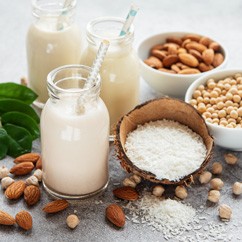People often confuse having a dairy allergy and being lactose intolerant. Although these two conditions may sound similar—and both are triggered by the consumption of foods derived from cow’s milk—the causes are starkly different. Symptoms can sometimes overlap such as abdominal or stomach upset, but how they affect your body is very different, too. Here’s a look at how these two milk-related conditions differ and how to manage them.

They involve different systems in the body
Lactose intolerance involves the digestive system and occurs when your body doesn’t produce lactase, the enzyme needed to digest lactose, the sugar found in milk. Without this enzyme, dairy moves undigested through your stomach and small intestine into your colon where it finally gets broken down by bacteria. This process can cause uncomfortable bloating, gas, vomiting, and diarrhea.
Dairy allergy involves the immune system. It is a response in which your body reacts to the proteins in milk and other dairy products as if they’re dangerous invaders. To protect itself, your body’s immune system releases substances that trigger an allergic reaction, which can range from mild to severe. Symptoms may include rash or hives, wheezing, swelling, tightness in the throat, upset stomach/vomiting (mostly in infants), and anaphylaxis, a potentially life-threatening allergic reaction.
Which one do you have?
If you find that eating dairy doesn’t agree with you, make an appointment to discuss your symptoms with a member of our dedicated care team. We can do tests to diagnose your condition, and then we can develop a treatment plan to address the root cause of your symptoms. In the meantime, here are some quick tips for managing lactose intolerance or dairy allergy.
Living with lactose intolerance can be challenging, but it’s not life-threatening. To keep it in check:
- Avoid dairy products as much as possible.
- Take lactase enzyme supplements before eating dairy.
- Buy lactose-free milk products.
- Choose dairy sources that have active cultures that make lactose easier to digest, such as yogurt.
According to Dr. Z, people living with a dairy allergy should avoid all milk-based foods, noting also that those who have anaphylactic reactions should carry an injectable epinephrine (EpiPen) at all times. This requires you to be vigilant.
- Learn how to read food labels, including how to recognize common dairy ingredients hidden in processed foods such as anything derived from whey.
- When eating out, ask about dairy used in food preparation and request plant-based substitutes.
- Discover ways to substitute milk products with plant-based ingredients in your favorite recipes.

Enjoy Plant-Based Alternatives
Non-dairy milk alternatives are a great way for people who need to avoid cow’s milk to enjoy the foods they love. Milks made from almonds, soy, rice, oats, coconut, and other plants are widely available in most grocery stores. Look for “unsweetened” varieties and read the nutrition labels as some brands contain a lot of added sugar and other unnecessary ingredients. When in doubt, making your own plant-based milk lets you control the ingredients that go into your milk.
At AAPRI and the Center for Functional Medicine, our holistic, integrated approach to care offers our patients a path to achieving long-term relief from symptoms and improved overall health. Schedule a consultation to learn more about how eating a healthy diet high in nutritionally dense foods such as fruits, vegetables, and healthy fats and proteins, can improve your gut health, reduce the severity of allergic reactions, and make living with a dairy allergy easier.

